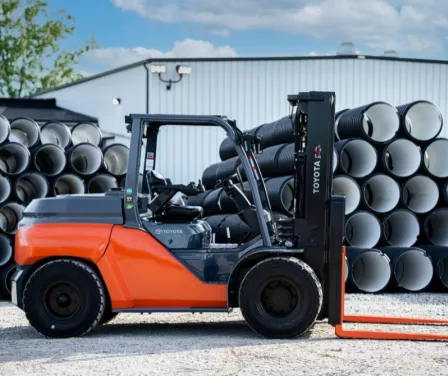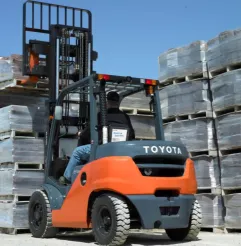Rent
ProLift offers daily, weekly, and monthly rentals. Find the right equipment for maximum productivity and safety.
Let us know how we can assist you! A ProLift specialist will connect with you to help with your material handling needs.

From increased load handling to specialized features, large capacity forklifts bring unique advantages to heavy-duty operations. ProLift explores the key differences that make large capacity forklifts essential for industries dealing with massive loads.

Depending on the industry and application, your facility may use a large capacity forklift, a unit with a capacity of 15,500 lb or more. Although these forklifts are operated inside the facility to move machinery, machinery dies and specialty manufactured product, oftentimes they are used outside, working on uneven and rough terrain.
While features of a large capacity forklift are similar to its smaller counterparts, they have subtle differences in maintenance and safety.
To maintain stability for both your large capacity forklift and its load, using the correct tires is essential. Mismatched tires—such as pairing new with worn tires, using different ply ratings, or combining bias and radial tires—on the front drive axle can throw off the forklift’s balance. Substituting truck tires as replacements can also cause problems, as the sidewalls may flex and give under heavy weight, potentially leading to costly repairs like a broken drive axle. Additionally, proper tire pressure is crucial to prevent issues such as cracked rims.
Because of the forklift’s large size, an operator may assume it can carry any load. It is important the operator understands the true load center of the unit both with and without a load. This information can be found on the forklift’s data tag(s).
Servicing large capacity forklifts demands specialized tools and resources. For instance, technicians may find radiators more compact, and working on the mast often requires two people. Inspections can also take longer and might require a manlift to access certain features. While some companies employ in-house technicians, many opt to outsource maintenance to avoid the significant investment in specialized tools, resources, and training required for large capacity forklifts.
If you have only one large capacity forklift, your production schedule will be vulnerable to a breakdown. The rough application exposes your forklift to dust, dirt, sand, etc., but placing your unit on a planned maintenance schedule will catch mechanical issues early. Calculate the number of hours the forklift is in use each day to determine an inspection schedule.
Whether you have a need to purchase or service a large capacity forklift, ProLift can help. We guarantee to respond to your breakdown call within 4 hours.

The equipment you have may not align with what you need. Collaborate with ProLift sales consultants to review your short- and long-term production goals, budgets, and material handling trends. They’ll provide tailored equipment options and solutions to meet your specific needs.
As a full-service material handling dealer, ProLift can help you with questions and solutions for your equipment, service, parts and more. Tell us how we can help.

Let us know how we can assist you! A ProLift specialist will connect with you to help with your material handling needs.
